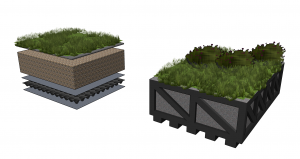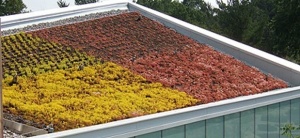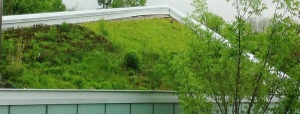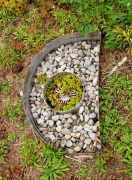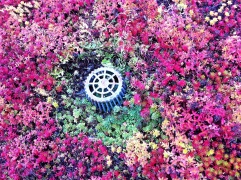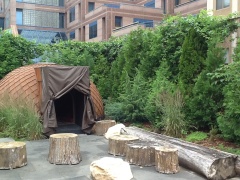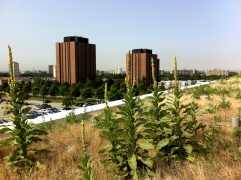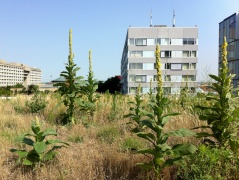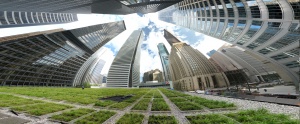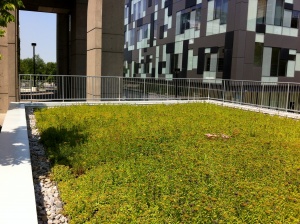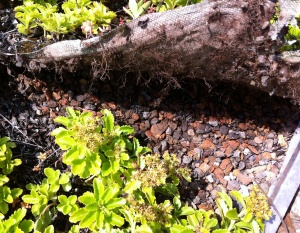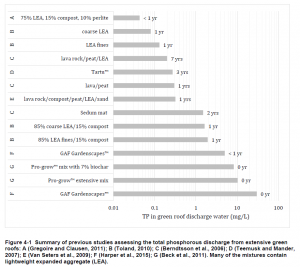Difference between revisions of "Green roofs"
Jenny Hill (talk | contribs) m (→Performance) |
Jenny Hill (talk | contribs) m (→Design) |
||
| Line 96: | Line 96: | ||
<h4>Filter Layer</h4> | <h4>Filter Layer</h4> | ||
The [[Geotextiles| geotextile]] layer is included to prevent migration of the planting medium into the drainage layer. Current advice is to specify a free draining textile to prevent potential water-logging of the planting medium. Observations green roof assemblies have shown a reduction of flow from specifications owing to interactions of medium particles with the textile. | The [[Geotextiles| geotextile]] layer is included to prevent migration of the planting medium into the drainage layer. Current advice is to specify a free draining textile to prevent potential water-logging of the planting medium. Observations green roof assemblies have shown a reduction of flow from specifications owing to interactions of medium particles with the textile. | ||
| + | |||
<h3>Planting Medium</h3> | <h3>Planting Medium</h3> | ||
{{:Green_roof_media}} | {{:Green_roof_media}} | ||
<h3>Irrigation</h3> | <h3>Irrigation</h3> | ||
| − | Regular irrigation has been shown to substantially reduce the stormwater capture benefit of an extensive green roof<ref | + | Regular irrigation has been shown to substantially reduce the stormwater capture benefit of an extensive green roof<ref name=Hill/>. |
One way to reduce the irrigation used on green roofs is through the use of smart technologies. Responsive sensors that suppress irrigation after a rainstorm are routinely attached to green roofs to conserve water. Improvements can be made by instead using a 'soil' moisture sensor to trigger irrigation. State-of-the-art management systems now use predicted weather data to suppress irrigation ahead of storm events, see [[digital technologies]]. | One way to reduce the irrigation used on green roofs is through the use of smart technologies. Responsive sensors that suppress irrigation after a rainstorm are routinely attached to green roofs to conserve water. Improvements can be made by instead using a 'soil' moisture sensor to trigger irrigation. State-of-the-art management systems now use predicted weather data to suppress irrigation ahead of storm events, see [[digital technologies]]. | ||
Due to their limited water retention capacity, many green roofs are coupled with a rainwater harvesting cistern, to capture the excess water. It then becomes desirable to use as much harvested water to regain the cistern capacity, Green roofs can be irrigated to saturation daily throughout the growing season without damaging the vegetation. | Due to their limited water retention capacity, many green roofs are coupled with a rainwater harvesting cistern, to capture the excess water. It then becomes desirable to use as much harvested water to regain the cistern capacity, Green roofs can be irrigated to saturation daily throughout the growing season without damaging the vegetation. | ||
Revision as of 02:05, 9 November 2017
Overview[edit]
Modern green roofs are a rapidly developing commercial market in Ontario. Their primary benefit as a LID technology is in maximizing evapotranspiration for water balance targets. Green roofs are sometimes referred to as 'ecoroofs', 'vegetated roofs', 'living roofs'.
Green roofs are ideal for:
- Sites without significant space at ground level for infiltration,
- Zero-lot line projects with outdoor amenity requirements,
- Projects looking for accreditation with LEED v.4
Extensive green roofs are the most commonly used type of green roof used for stormwater in our region.
| Property | Extensive | Intensive |
|---|---|---|
| Planting medium depth | 10 - 15 cm | > 15 cm |
| Loading | up to ~250 kg/m2 | Limitless where 'roof' is at ground level |
| Cost | Typically lower | Higher, including structural accommodations and plant selection |
| Maintenance | Depends highly on the aesthetic expectations of stakeholders | Will be comparable to other landscapes, depending on access requirements. |
| Stormwater benefit | Provides best cost-benefit balance | Varies highly |
| Biodiversity benefit | Lower, depends on planting | Greater potential, depends on planting |
| Amenity benefit | Usually visual only i.e. inaccessible |
Often accessible |
Intensive green roofs are commonly used for amenity space on condo developments or sometimes as urban farms. They are sometimes referred to as roof gardens and encompass diverse uses, design priorities and technical specifications. In the most extreme examples, many urban parkettes including large shade trees may be included in this class, if they have parking garages beneath. As such the discussion on this page is limited to extensive green roofs.8
The fundamental components of an extensive green roof are:
- a roof able to withstand the load
- a roof membrane resistant to root penetration
- a drainage layer
- a filter layer
- a layer of planting medium
- plants
Additional components may include:
- an irrigation system
- pre-formed tray modules
Planning Considerations[edit]
Green roofs offer a variety of co-benefits beyond stormwater management. In urban centers they are often constructed to accommodate a roof terrace or amenity space. In this scenario the direct stormwater capture benefit is restricted to the areas with vegetation planted. Another increasingly popular use for rooftop space is for urban farming. Again, the direct stormwater capture benefit is restricted to the areas with planters. To maximize the utility of a green roof as a low impact development tool, coverage with planting should be maximized. In many cases this means only inaccessible spaces are used.
Amenity
Roof gardens with a high proportion of impermeable surface are popular in high rise developments. These amenity terraces are often described as green roofs, but the LID benefit applies only to the vegetated areas. The stormwater benefit of all kinds of green roofs is maximized by combined with rainwater harvesting for subsequent irrigation. Sedum and native species have all been shown to thrive with daily irrigation to saturation[1].
Rooftop farming is also becoming common in some Ontario cities. Again consideration should be given to the proportion of the roof actually planted. Where large open expanses of roof are being cropped, measures may be required to reduce erosion of exposed planting medium. Any digging or furrows will reduce the stormwater benefit.
Biodiversity
Biodiversity opportunities are optimized by planting a variety of species. General advice on this has been prepared by the City of Toronto[2]. In the long term, the richness of species increases owing to 'volunteer species'. The desirability of this diversity varies with the aesthetic concerns of the green roof owner.
Design for Maintenance
Detailed inspection and maintenance advice can be found in Sustainable Technologies' LID I&M guide [3]. The primary operational concern for operating a green roof is the development of a leak. Green roofs protect the roof membrane from UV damage and should increase the lifespan of the roof. However, in the event that a leak is discovered a section of green roof would have to be removed for access. Some proprietary systems appear to be easier to remove and replace. This may come at a cost, as the rainwater retention of the system is somewhat reliant on continuous coverage of the green roof surface.
Green roofs should receive as little maintenance as possible. Regular inspection is only required to see that the drains are free from obstruction and that the vegetation coverage is adequate to prevent wind erosion. During detailed design, all areas adjacent to the green roof itself should be kept free from granular material. Sediment accumulates in gravel edging, which then permits the vegetation to take root and spread.
Design[edit]
Roof
Flat roofs should be graded without depressions, with positive drainage ≥2% (1:50) towards roof drains. For roofs with pitch greater than 10% (1:10) additional check dams or cellular components should be included in the design. These structures reduce the flow rate of the draining water, and help to stabilize green roof components. Green roofs can be installed on slopes greater than 20% (1:5), but specialized design advice should be sought for the addition of components required to secure the green roof in place. Extensive green roofs do not require additional insulation layers. The underlying roof may be of warm, cold or inverted design. Extensive green roofs add load of around 70 - 300 kg/m2. A structural engineer should be consulted during design to account for the distributed loads including snow accumulation and live loads including maintenance staff. Roof membranes should be waterproof, root resistant, resilient to temperature change, and comply with appropriate CGSB standards as specified in the Ontario Building Code. In most cases a new roof with a modern membrane will not require a separate root penetration barrier. In retrofit scenarios an additional root barrier may be recommended to protect an older roof membrane.
Drainage Layer
The underlying drainage layer is most often a preformed plastic sheet, formed to include depressions for water storage and perforations to drain excess water. This design has the advantage of being most lightweight, but has minimal impact on flow rates once the water has percolated onto the roof membrane below. An alternative drainage layer solution is to use a granular medium to increase the tortuosity of the flow path and slow peak flow rates.
Filter Layer
The geotextile layer is included to prevent migration of the planting medium into the drainage layer. Current advice is to specify a free draining textile to prevent potential water-logging of the planting medium. Observations green roof assemblies have shown a reduction of flow from specifications owing to interactions of medium particles with the textile.
Planting Medium
The green roof media used in Ontario can be classed according to proportion of composted biological material. Some existing installations use materials which comply with FLL guidelines, whilst others use a much higher proportion of compost[4].
ASTM International have a number of standards relating to various design considerations for green roofs. These standards provide good technical advice on the testing of systems and components. Of particular note are:
- Standard Test Method for Maximum Media Density for Dead Load Analysis of Vegetative (Green) Roof SystemsE2399, and
- Test Method for Saturated Water Permeability of Granular Drainage Media E2396.
When these tests are completed, the results should be interpreted in relation to the objectives of the green roof. A product complying with overseas guidelines may not serve the needs of a green roof installed in Ontario. In particular, the FLL guide recommends green roof media specifications which may not provide optimal stormwater management or vegetation in our region.
In many proprietary systems the default option for planting medium will be a granular material with very low organic matter content. However, many companies can arrange for a high organic matter alternative to be substituted if requested.
Increasing the depth of planting medium from 10 cm to 15 cm has been shown to benefit the vegetation [5], however stormwater retention was not improved with this increase in depth [6]
| Benefits | Disadvantages |
|---|---|
|
|
Irrigation
Regular irrigation has been shown to substantially reduce the stormwater capture benefit of an extensive green roof[7]. One way to reduce the irrigation used on green roofs is through the use of smart technologies. Responsive sensors that suppress irrigation after a rainstorm are routinely attached to green roofs to conserve water. Improvements can be made by instead using a 'soil' moisture sensor to trigger irrigation. State-of-the-art management systems now use predicted weather data to suppress irrigation ahead of storm events, see digital technologies. Due to their limited water retention capacity, many green roofs are coupled with a rainwater harvesting cistern, to capture the excess water. It then becomes desirable to use as much harvested water to regain the cistern capacity, Green roofs can be irrigated to saturation daily throughout the growing season without damaging the vegetation.
| Irrigation technology | Benefits | Disadvantages |
|---|---|---|
| Spray | Maximizes evaporation | Requires higher water quality |
| Drip or capillary | Harvested rainwater is readily used without further treatment Uses less water |
Planting medium does not 'wick' water sideways readily, so can lead to localized dry areas |
Maximizing evaporation with spray irrigation is the faster way to empty a stormwater cistern, and provides some cooling benefit for the building and it's surroundings.
Planting
The choice of vegetation on an extensive green roof is insignificant in stormwater management compared to the choice of planting medium or the provision of irrigation. The vegetation should be selected to be resilient to both very wet and very dry periods.Sedum species are the most common choice, demonstrating excellent longevity in systems with or without irrigation. Some projects expect the low growing Sedum to remain in graphic designs according to species and flower color. This is not a realistic expectation without significant maintenance costs. Instead project stakeholders should be prepared early in the design process to embrace the green roof as a living and evolving ecosystem. Designs which incorporate both Sedum and native species can help with this. See: Planting for Green Roofs
Drains and Vegetation Free zones
Vegetation free areas are often required around the perimeter of the roof to reduce wind uplift, on larger areas requiring firebreaks, for access paths and around drains. To prevent accumulation of sediment and migration of the vegetation, the vegetation free areas should not be filled with decorative aggregate or river rock. Instead concrete pavers or other surfaces that do not actively trap particles will reduce weeding maintenance.
Performance[edit]
Controlled studies have indicated that maturing green roofs may have improved water retention properties [8].
The key hydrologic benefit which green roofs have over other forms of LID is the proportion of the water returned to the atmosphere through evapotranspiration.
- In Southern Ontario rainwater retention of extensive green roofs without irrigation is between 60% and 70%[9] [10] [7].
- Including winter periods with snow accumulation and thaw, the annual retention of extensive green roofs is around 50% [10][7].
- Using a compost based planting medium improves retention by around 10% i.e. 60 % for compost compared to 50% for granular.
- Daily irrigation can reduce the annual retention by 20% compared to a roof without irrigation. i.e. 40% for irrigated compared to 60% without irrigation[7]. However, recirculating rainwater from a cistern was estimated to double the annual retention in Florida[11]. The research team modeled 87% retention for a green roof coupled with a cistern, compared to 43% for the green roof alone.
An appropriate NRCS curve numbers for green roofs without irrigation in Southern Ontario is 90 [12][7].
Water quality[edit]
Many green roofs receive only rainwater, which is relatively free of contaminants like nutrients and heavy metals, but can contribute contaminants to roof runoff, most notably through leaching of Nutrients from the growing medium substrate during early establishment.[13] Reported concentrations of Total Phosphorus in green roof runoff have been observed to vary from less than 0.1 ppm to over 10 ppm.[14]. To improve the quality of runoff from green roofs, Vijayaraghavan et al. (2018) recommend considering the sorption capacity of the growing medium substrate, the phytoremediation potential of plants and incorporation of sorbent Additives to growing medium substrates.[15]
In dense urban centres, green roofs are increasingly being used to receive irrigation from harvested rainwater. Current Ontario Building Code permits the use of rooftop runoff for landscape irrigation purposes, so long as it is 'free of solids'. A 'closed loop' system can be created by coupling a rainwater harvesting system with a green roof and harvesting and reusing roof runoff as a source of water for irrigation during dry periods, so the only water leaving the system is through evapotranspiration. This can prevent runoff from leaving the site and thereby prevent contaminant loading to the environment.
References[edit]
Incentives and Credits[edit]
In Ontario
City of Toronto updated their 'Eco roof' incentive program in 2017 . It now includes grants for structural assessment and is available to non-profit organisations [1].
LEED BD + C v.4
LEED offer a relatively large number of points for green roofs compared to other LID technologies.
Sustainable Sites: Open space (1 point) This credit applies to accessible green roofs on tall buildings with little other outdoor space[2].
Sustainable Sites: site development - protect or restore habitat (up to 2 points) This credit applies to green roofs planted with 'native and adapted vegetation' on tall buildings with little other outdoor space[3].
Sustainable Sites: Heat island reduction (up to 2 points) Green roofs are weighted as effectively as 'High-Reflectance' roofs in a simple calculation to determine the credit[4].
Sustainable sites: Rainwater management (up to 3 points)
- Two points (or 1 point for Healthcare) will be awarded if the project manages "the runoff from the developed site for the 95th percentile of regional or local rainfall events."
- Three points (or 2 points for Healthcare) will be awarded if the project manages "the runoff from the developed site for the 98th percentile of regional or local rainfall events."
OR
- For zero-lot-line projects only, 3 points (or 2 points for Healthcare) will be awarded if the project manages "the runoff from the developed site for the 85th percentile of regional or local rainfall events."
SITES v.2
External Links[edit]
Proprietary Systems
In our effort to make this guide as functional as possible, we have decided to include proprietary systems and links to manufacturers websites.
Inclusion of such links does not constitute endorsement by the Sustainable Technologies Evaluation Program.
Lists are ordered alphabetically; link updates are welcomed using the form below.
- ↑ http://grit.daniels.utoronto.ca/green_roof_image_index/#
- ↑ https://www1.toronto.ca/City%20Of%20Toronto/City%20Planning/Zoning%20&%20Environment/Files/pdf/B/biodiversegreenroofs_2013.pdf
- ↑ http://www.sustainabletechnologies.ca/wp/wp-content/uploads/2016/08/LID-IM-Guide-7.6-Green-Roofs.pdf
- ↑ Hill, J., Drake, J., and Sleep, B. (2016). “Comparisons of extensive green roof media in Southern Ontario.” Ecological Engineering, Elsevier B.V., 94, 418–426. https://www.sciencedirect.com/science/article/abs/pii/S0925857416302804?via%3Dihub
- ↑ MacIvor JS, Margolis L, Puncher CL, Carver Matthews BJ. Decoupling factors affecting plant diversity and cover on extensive green roofs. J Environ Manage. 2013;130:297-305. https://www.sciencedirect.com/science/article/abs/pii/S0301479713006051?via%3Dihub
- ↑ Hill, J., Drake, A. P. J., Sleep, B., and Margolis, L. (2017). “Influences of Four Extensive Green Roof Design Variables on Stormwater Hydrology.” Journal of Hydrologic Engineering. https://ascelibrary.org/doi/abs/10.1061/%28ASCE%29HE.1943-5584.0001534
- ↑ 7.0 7.1 7.2 7.3 7.4 Hill J, Drake J, Sleep B, Margolis L. Influences of Four Extensive Green Roof Design Variables on Stormwater Hydrology. J Hydrol Eng. 2017;22(8):04017019. doi:10.1061/(ASCE)HE.1943-5584.0001534
- ↑ Simon De-Ville, Manoj Menon, Xiaodong Jia, George Reed, Virginia Stovin, The impact of green roof ageing on substrate characteristics and hydrological performance, In Journal of Hydrology, Volume 547, 2017, Pages 332-344, ISSN 0022-1694, https://doi.org/10.1016/j.jhydrol.2017.02.006.
- ↑ Liu, M. Minor, J. 2005. Performance evaluation of an extensive green roof. National Research Council of Canada. NRCC-48204 https://sustainabletechnologies.ca/app/uploads/2013/03/NRC_EastviewGRrept.pdf
- ↑ 10.0 10.1 T. Van Seters, L. Rocha, D. Smith, G. MacMillan; Evaluation of Green Roofs for Runoff Retention, Runoff Quality, and Leachability, Vol. 44 (1): 33 - 47 (2009). Innovative Approaches to Stormwater Management in Canada
- ↑ Hardin, M.; Wanielista, M.; Chopra, M. A Mass Balance Model for Designing Green Roof Systems that Incorporate a Cistern for Re-Use. Water 2012, 4, 914-931. http://www.mdpi.com/2073-4441/4/4/914
- ↑ Curve Number and Runoff Coefficients for Extensive Living Roofs Elizabeth Fassman-Beck, Ph.D., A.M.ASCE; William Hunt, Ph.D., P.E., M.ASCE; Robert Berghage, Ph.D.; Donald Carpenter, Ph.D., P.E., M.ASCE; Timothy Kurtz, P.E., M.ASCE; Virginia Stovin, Ph.D.; and Bridget Wadzuk, Ph.D., A.M.ASCE
- ↑ Vijayaraghavan, K., Harkishore Kumar Reddy, D., Yun, Y. 2018. Improving the quality of runoff from green roofs through synergistic biosorption and phytoremediation techniques: A review. Sustainable Cities and Society. 46 (2019) 101381. https://www.sciencedirect.com/science/article/abs/pii/S2210670718319383?via%3Dihub
- ↑ Hill J., Drake J., Sleep B., Margolis L. 2017. Influences of Four Extensive Green Roof Design Variables on Stormwater Hydrology. J Hydrol Eng. 2017;22(8):04017019. doi:10.1061/(ASCE)HE.1943-5584.0001534
- ↑ Vijayaraghavan, K., Harkishore Kumar Reddy, D., Yun, Y. 2018. Improving the quality of runoff from green roofs through synergistic biosorption and phytoremediation techniques: A review. Sustainable Cities and Society. 46 (2019) 101381. https://www.sciencedirect.com/science/article/abs/pii/S2210670718319383?via%3Dihub
